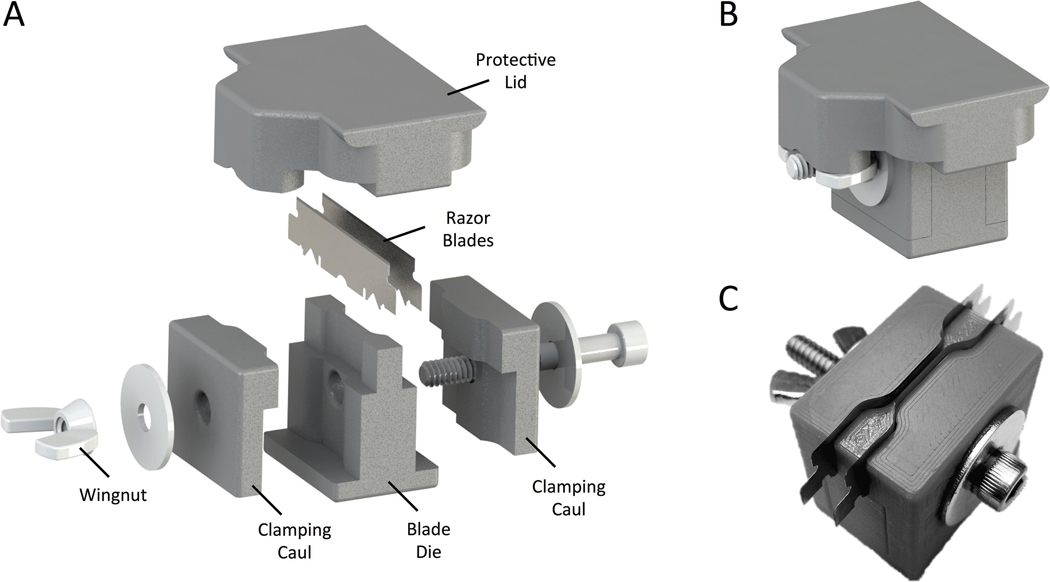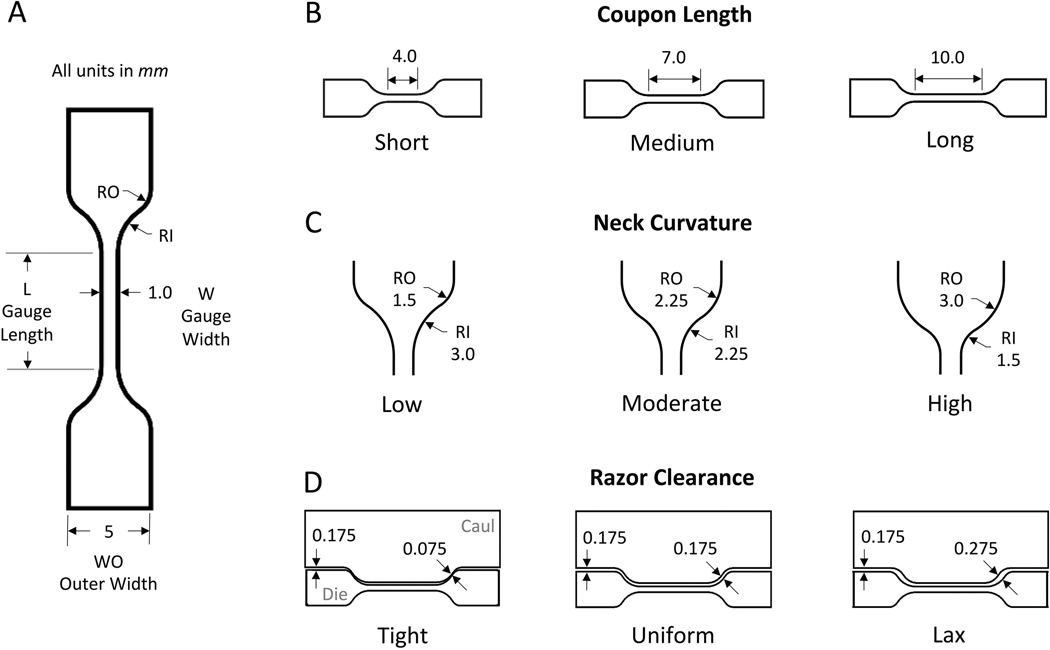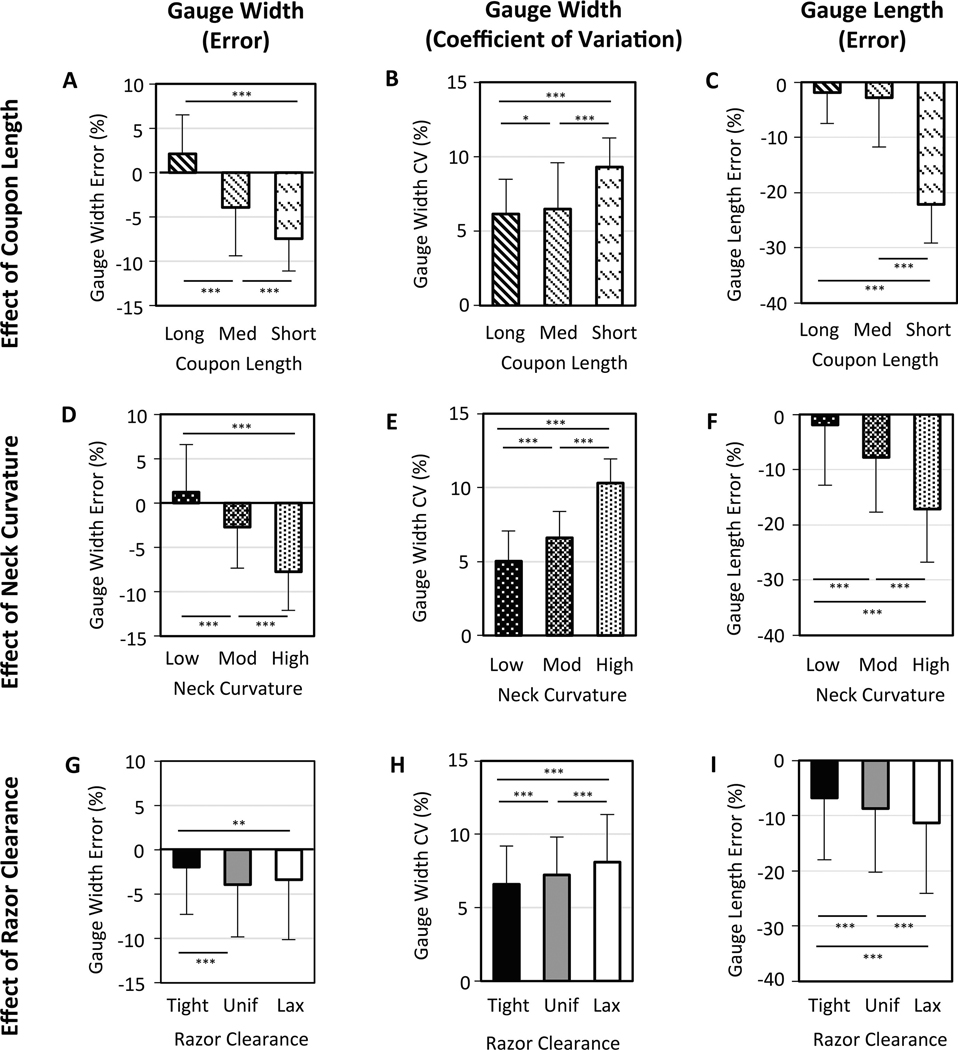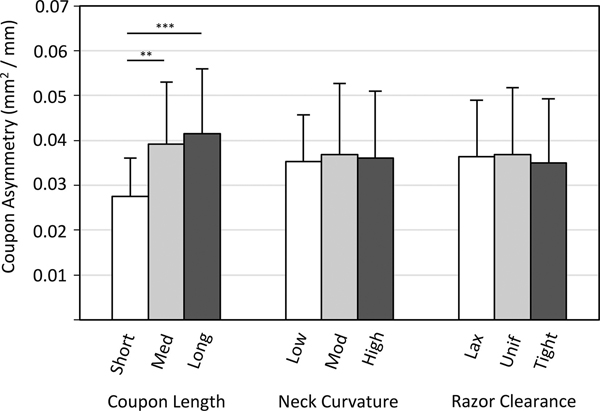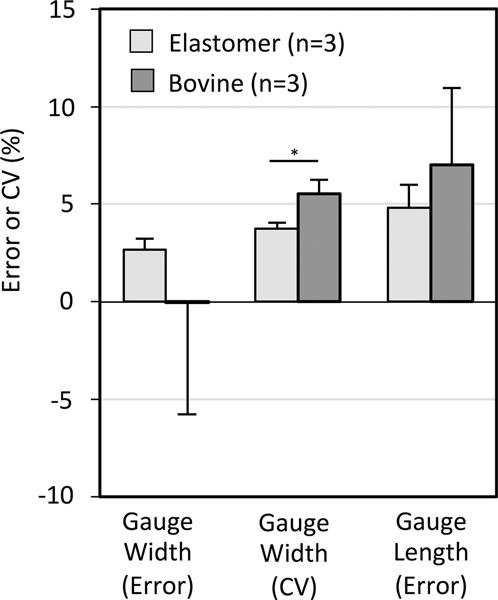Abstract
The failure behavior and mechanical properties of soft tissue can be characterized by conducting uniaxial tensile tests on small sectioned specimens, called test coupons. An ideal coupon geometry for tensile testing is a dumbbell shape (dog-bone), yet the cost and time required to fabricate custom steel punches to cut dumbbell-shaped coupons has hindered their universal application in biomechanics research. In this study, we developed an economical and reliable cutting device that can extract dumbbell-shaped coupons from soft biological tissue. The novel device, called Print-A-Punch, uses three-dimensional (3D) printed components in combination with standard fasteners and replaceable flexible razors. We identified design factors that influence the dimensional accuracy and symmetry of elastomer coupons extracted using this cutting device, and demonstrated its use on bovine meniscus. Advantages of this 3D printed device include a fast fabrication time, low material cost, good accuracy (within 5% of targeted dimensions), replaceable blades, and an ability to scale coupon dimensions for specific tissues and experiments. By reducing the cost and time to cut accurate dumbbell-shaped coupons, this technology can facilitate the broad adoption of standard test methods that improve the quality and reproducibility of tensile tests in soft biological tissue. Researchers can freely download a set of STL files from this study to build their own Print-A-Punch device (https://boisestate.edu/coen-ntm/technology/print-a-punch).
Keywords: ultimate tensile strength, tissue punch, connective tissue, dog-bone specimen, meniscus
1. INTRODUCTION
Tensile tests are a fundamental experiment to characterize the mechanical properties of soft biological tissue. Data from tensile tests is used to quantify the material strength of connective and epithelial tissues (Kolz et al., 2015; Ní Annaidh et al., 2012), and to determine the effect of microstructure, disease, and therapy on tissue function (Fischenich et al., 2015; Hauser and Dolan, 2011; Oxlund, 1980; Stender et al., 2017). To ensure the validity and reproducibility of tensile tests, the test specimens, called coupons, must be designed to have proper geometry within specified tolerances. International test standards of many conventional materials (ASTM, 2003) require the use of dumbbell-shaped coupons that promote failure in a region of uniform tensile stress, called the gauge section. By distributing the compressive forces needed to securely grip the specimen, the dumbbell shape reduces the risk of “premature” failure at or near the grips, where the stress state is more complex than simple tension (Davis, 2004).
While dumbbell-shaped coupons have been previously used by numerous research groups for tensile testing of soft tissue, there is no standardized method for cutting these coupons. The two most common methods are with a scalpel and cutting guide (Scholze et al., 2018) or a custom fabricated steel punch (Kemper et al., 2010; Quapp and Weiss, 1998). Although using scalpels with cutting guides provides an inexpensive, low-maintenance method that can be quickly implemented, the resulting coupon geometry is operator dependent and prone to large inter- and intra-specimen variations in dimensions. Conversely, custom fabricated steel punches can provide repeatable and accurate coupon geometry, but they are expensive, require considerable time to fabricate, and need periodic maintenance to sharpen the cutting edge. A need therefore exists to develop a novel cutting device for soft tissue that overcomes these stated limitations and thereby facilitates the broad adoption of proper test methods for biomechanical tensile testing.
The objective of this study was to develop an accurate and economical cutting device that can extract dumbbell-shaped specimens from soft biological tissue. The proposed device uses 3D printed components in combination with standard fasteners and replaceable flexible razors. This study analyzed design factors that may influence the dimensional accuracy of this novel device, and then tested this device on bovine meniscus.
2. MATERIALS AND METHODS
2.1. Device Design and Development.
The cutting device had three primary design criteria (Table 1). Device components include 3D printed parts (cauls, die, and protective lid), standard fasteners, and flexible steel razors (Fig. 1). The 3D printed parts were designed in Solidworks (Waltham MA; version 25) and printed using an MK3 3D printer (Prusa, Prague CZ). The flexible razor blades (Azmusebat-Derby, Istanbul TU; Single Edge) are bent into the desired geometry by pressing them between the blade die and the clamping cauls (Fig. 1A). The blade die has a flat ledge for the blades to rest upon during clamping. The protective lid doubles as a tightening assist that anchors the wingnut (Fig. 1B) when fastening together the bolt assembly with a hex key. The size of the washers and the caul thickness was selected to apply a volumetric stress distribution (i.e. frustum) capable of reliably bending the razors with a single bolt (Fig. 1C). To cut a dumbbell coupon, a layer of tissue is placed on a plastic base plate, the protective lid is removed, the punch blades are positioned over the tissue, and a mallet is used to strike the top of the cutting device.
Table 1.
Device Design Criteria and Corresponding Design Features.
| Design Criteria | Design Features |
|---|---|
|
| |
| 1) Accurate dumbbell geometry | Interlocking parts that bend razors onto a dumbbell-shaped die |
| 2) Blades can be safely replaced | Protective lid that anchors the bolt assembly when tightening |
| 3) Fast and economical to produce | 3D printed parts, standard fasteners, and disposable razors |
Fig. 1.
Device components and assembly. A) The device consists of four 3D printed components, two replaceable razor blades, and four hardware components. B) When assembled, a protective lid covers the razor blades and holds the wingnut in place. C) By tightening the bolt, the clamping cauls bend the flexible razors into the dumbbell shape of the blade die. Note: images in panels A and B were generated with CAD software, while image C is a photo of the actual device.
2.2. Effect of Design Factors on Dimensional Accuracy.
The ability of the device to produce coupons with desired dumbbell geometry was analyzed by varying the following three design factors: coupon length, neck curvature, and razor clearance (Fig. 2A–D). In total twenty-seven punches were printed to represent all possible variations of the design factors. The overall length and width of the printed punches was verified using digital calipers to have an error less than 3%. Details on the rationale for the different tested designs is provided in the supplemental documents.
Fig. 2.
This study evaluated the effect of three design factors on the dimensional accuracy of the cutting device. A) All coupons used the same gauge width and outer width. B) Coupon length was varied by increasing the gauge length. B) Neck curvature was varied by changing the aspect ratio between the inner and outer radius, where low neck curvatures have the most gradual slope near the gauge region. D) Razor clearance represents the fit between the curved regions of the caul and blade die, where a uniform razor clearance has a consistent gap between engineered parts to accommodate the exact thickness of the razor. All units are in mm.
Each unique device design was used to punch three specimens from neoprene rubber sheets that were 0.4 mm thick. The razor blades were replaced prior to cutting each unique design. Each specimen was imaged next to a calibration square with a digital camera that provided a conversion factor of 48.3 ± 0.4 pixels per mm (Fig. 3A). The digital camera was fixed in a stand 70 mm above the imaging space for the duration of the experiment to ensure imaging repeatability between specimens.
Fig. 3.
Dimensional analysis of dumbbell coupons. A) The calibration square and elastomer coupon were imaged, cropped (white box), and B) segmented to create a width distribution plot. Mean gauge width was measured in the center span, and the intra-specimen variation in gauge width was measured within the target gauge length (GL), where the target values match the designed dimensions of the device. The upper and lower limits of effective GL were detected when width variation exceeded 5%. C) Coupons were centered about a vertical axis (white dashed line) and asymmetry of the coupon about this axis was quantified. D) These same operations were applied to bovine meniscus.
Images were analyzed to evaluate error in cutting specimens to their targeted dimensions. Four metrics were analyzed: mean gauge width, intra-specimen variation in gauge width (coefficient of variation), effective gauge length, and coupon symmetry. The methods used to acquire the first three metrics are summarized in Figure 3 (Fig. 3A–B), and a more detailed description is available in the supplemental documents. The fourth metric, coupon asymmetry, was measured by first centering cropped coupon images by applying iterative translations and rotations until minimizing the absolute difference in pixels between the binarized image and the same image mirrored about the vertical axis (Fig. 3C). The minimized pixel value was converted to area and normalized to the length of the coupon perimeter (units: mm2 / mm). This value for asymmetry was calculated for the whole coupon and individual regions (i.e. gauge section, width tapered region). A lower asymmetry value signifies a more symmetric specimen.
2.3. Application to Soft Tissue.
The dimensional accuracy of the device was tested on three bovine meniscus specimens that were layered to ~1 mm thickness (Creechley et al., 2017). For this bovine test, a medium-low-lax punch design was selected (Fig. 2). Each bovine specimen was punched and manually preloaded in tension until the specimen was taut (Fig. 3D). Image acquisition and analysis followed the previously described procedure for the elastomer specimens.
2.4. Statistical Analysis.
The effect of design factors (coupon length, neck curvature, razor clearance) and material type (elastomer vs bovine) on dimensional accuracy (% error, coefficient of variation, and asymmetry) were assessed using MANOVAs with Bonferroni post hoc testing.
3. RESULTS
3.1. Effect of Design Factors on Dimensional Accuracy.
All three design factors significantly influenced the dimensional accuracy of the dumbbell-shaped coupons (Fig. 4). In general, dimensional accuracy was best when using longer coupons (Fig. 4A–C) with a low neck curvature (Fig. 4D–F) and tight razor clearance (Fig. 4G–I). These trends were also supported by the significant interactions measured between all the design factors. Dimensional errors increased the most when increasing the neck curvature from low to high, and increasing the coupon length from short to large.
Fig. 4.
Effect of punch design factors on dimensional accuracy of the dumbbell specimens. Dimensional accuracy was improved when A-C) using longer coupons with greater gauge lengths, D-F) using neck curvatures that gradually tapered near the gauge region, and G-l) having a tight razor clearance between the caul and die in the curved neck regions. ***p < 0.001, **p < 0.01, *p < 0.05.
Coupon symmetry was largely insensitive to device design (Fig. 5), except that short coupons were 2–3x more symmetric in the gauge section than longer coupons (p<0.001), leading to overall differences in coupon asymmetry (Fig. 5), and coupons with high neck curvature had less symmetry in the width tapered region than coupons with low neck curvature (p=0.03).
Fig. 5.
Asymmetry of the elastomer dumbbell coupons about a vertical axis. Shorter coupons were more symmetric than their counterparts, but overall, design factors had little influence on overall coupon symmetry. ***p < 0.001, **p < 0.01.
3.2. Application to Soft Tissue.
Dumbbell coupons of bovine meniscus exhibited greater intra-specimen variations in gauge width (p=0.01) and had greater inter-specimen variations in gauge width and length (i.e. higher standard deviation) compared to dumbbell coupons of elastomers (Fig. 6). The only difference in symmetry was that the width tapered region of meniscus coupons was roughly two times more asymmetric than elastomer coupons (p=0.03).
Fig. 6.
Comparison of dimensional accuracy between elastomer and bovine meniscus coupons using a cutting device with a medium-low-lax design. Bovine specimens had a greater coefficient of variation (CV) in the gauge region. *p < 0.05.
4. DISCUSSION
This study developed and validated a novel device to cut dumbbell-shaped specimens from soft tissue. The design utilizes 3D printing and flexible razors to achieve the design criteria (Table 1) and overcome noted limitations of prior techniques. Benefits of this cutting device include fast fabrication time (less than 5 hours), affordability (material cost less than $5 USD), replaceable blades, and good dimensional accuracy.
An innovative aspect of our cutting device is the bending of malleable steel razors onto a dumbbell-shaped die (Fig. 1). It was therefore necessary to identify design factors that affect the fidelity between the die design and coupon geometry. We found that using a coupon that gradually tapers near the gauge section (low neck curvature) will greatly improve the dimensional accuracy (Fig. 4D–F), possibly due to less springback of the razor at the gauge limits. We also found that dimensional accuracy was worse for shorter specimens. While the effective gauge length for medium and long specimens were within 5% of their targeted dimensions, shorter specimens had over 20% error. One explanation is that decreasing the gauge length will subject the 3D printed parts to greater stress and deflection. It is therefore recommended to account for decreases in the effective gauge length when using this device on shorter specimens. Another design factor we considered was the amount of clearance allocated in the curved dumbbell region for the razor thickness. Tighter clearances showed slight improvements (Fig. 4G–I), likely by restricting degrees of freedom. Since a low neck curvature and a tight razor clearance had the best average dimensional accuracy (Fig. 4), we selected the STL files (caul and die) with these specific design factors for short, medium, and long coupons, and made them freely available for non-commercial use (https://www.boisestate.edu/coen-ntm/technology/print-a-punch). All other STL files used in this study are available upon request.
The dimensional accuracy of the device was evaluated using uniform elastomer sheets to minimize confounding factors due to material variability. Most elastomer coupons cut with our device had mean gauge dimensions within 5% of targeted values, and had width variability along the gauge length of ~5% (Fig. 4). The dumbbell geometry was also symmetric, with the average asymmetry accounting for less than 5% of the 1 mm gauge width (Fig. 5). A validation test was then performed on a small number of bovine meniscus to demonstrate the application of this device to dense connective tissue. Although meniscus coupons had larger intra- and inter-specimen variations in dumbbell dimensions compared to their elastomer counterparts (Fig. 6), the dimensional accuracy of the meniscus coupons remained within 10% of targets. Meniscus coupons also had more pronounced asymmetry in the width tapered regions than elastomer coupons, perhaps due to their heterogeneous fiber-composite structure.
The gold standard for cutting dumbbell coupons from soft tissue is a machined steel punch (Quapp and Weiss, 1998), yet the cost and time to machine these tools has limited their broad adoption by research groups. For example, in an independent survey of twenty recently published studies that conducted tensile tests to failure on soft tissue, only 40% cut dumbbell coupons with a custom punch, 25% cut dumbbell coupons with a scalpel or razor, and 35% used straight (rectangular) coupons rather than dumbbell coupons. Our device leverages 3D printing technology to create an economical tool that has fast turnaround times between designing a custom dumbbell geometry and cutting the tissue. This is valuable when testing anisotropic biological tissue, since specific tissues and experiments can require different sized coupons. Another advantage of our device is that unlike machined steel punches, the blades are disposable and don’t require maintenance. Sharp cutting blades are critical for eliminating defects along the coupon edge that potentially influence material behavior, and therefore ASTM International requires that dumbbell-shaped dies “shall at all times be sharp and free of nicks” (ASTM, 2006). By covering the razors with the protective lid when applying torque to the bolt with a hex key (Fig. 1A), the razors can be safely replaced in under two minutes.
The device and study also have some limitations. First, relative to custom steel punches that are machined to tight tolerances, this 3D printed device will intrinsically have less dimensional accuracy. Second, feasible coupon designs will be limited by the razor dimensions. We estimate that the razors used in this study could cut specimens up to 1.5 mm thick with gauge lengths up to 15 mm. Finally, this study tested the dimensional accuracy of the device, but tensile tests were not performed. These experiments were outside the scope of this study, and the benefit of dumbbell-shaped coupons in reducing grip failures in soft tissue is already well established (Abdelgaied et al., 2015; Freutel et al., 2015; Krentz et al., 2017).
In summary, this study has introduced an innovative cutting tool to cut dumbbell-shaped coupons from layers of soft tissue. This device can support the broad adoption of standard test methods that improve the quality and reproducibility of tensile tests in soft biological tissue.
Supplementary Material
ACKNOWLEDGEMENTS
This project was supported by the National Science Foundation under grant no. 1554353 and the National Institute of General Medical Sciences under grant no. P20GM109095. We also acknowledge Greenfield Meats (Meridian, ID) for their donation of bovine knee joints.
Footnotes
Publisher's Disclaimer: This is a PDF file of an unedited manuscript that has been accepted for publication. As a service to our customers we are providing this early version of the manuscript. The manuscript will undergo copyediting, typesetting, and review of the resulting proof before it is published in its final form. Please note that during the production process errors may be discovered which could affect the content, and all legal disclaimers that apply to the journal pertain.
CONFLICT OF INTEREST STATEMENT
All authors (SN, JC, MW, TL) are co-inventors on a patent submitted by Boise State University for the cutting device described in this study. The authors have no other affiliations with or involvement in any other entity with any financial interest.
BIBLIOGRAPHY
- Abdelgaied A, Stanley M, Galfe M, Berry H, Ingham E, Fisher J, 2015. Comparison of the biomechanical tensile and compressive properties of decellularised and natural porcine meniscus. J. Biomech 10.1016/j.jbiomech.2015.02.044 [DOI] [PubMed] [Google Scholar]
- ASTM, 2006. Standard Test Methods for Vulvanized Rubber and Thermoplastic Elastomers - Tension (D 412 – 06a). West Conshohocken, PA. [Google Scholar]
- ASTM, 2003. Standard Test Method for Tensile Properties of Plastics (D638–02a). West Conshohocken, PA. [Google Scholar]
- Creechley JJ, Krentz ME, Lujan TJ, 2017. Fatigue life of bovine meniscus under longitudinal and transverse tensile loading. J. Mech. Behav. Biomed. Mater 69. 10.1016/j.jmbbm.2016.12.020 [DOI] [PMC free article] [PubMed] [Google Scholar]
- Davis JR, 2004. Tensile testing (2nd ed.). Tensile Test. 10.1361/ttse2004p001 [DOI] [Google Scholar]
- Fischenich KM, Lewis J, Kindsfater KA, Bailey TS, Haut Donahue TL, 2015. Effects of degeneration on the compressive and tensile properties of human meniscus. J. Biomech 48, 1407–1411. 10.1016/j.jbiomech.2015.02.042 [DOI] [PubMed] [Google Scholar]
- Freutel M, Scholz NB, Seitz AM, Ignatius A, Dürselen L, 2015. Mechanical properties and morphological analysis of the transitional zone between meniscal body and ligamentous meniscal attachments. J. Biomech 10.1016/j.jbiomech.2015.03.003 [DOI] [PubMed] [Google Scholar]
- Hauser R, Dolan E, 2011. Ligament Injury and Healing: An Overview of Current Clinical Concepts. J. Prolotherapy 10.1002/14651858.CD003762 [DOI] [Google Scholar]
- Kemper AR, Santago AC, Stitzel JD, Sparks JL, Duma SM, 2012. Biomechanical response of human spleen in tensile loading. J. Biomech 45 (2), 348–355. 10.1016/j.jbiomech.2011.10.022. [DOI] [PubMed] [Google Scholar]
- Kolz CW, Suter T, Henninger HB, 2015. Regional mechanical properties of the long head of the biceps tendon. JCLB 30, 940–945. 10.1016/j.clinbiomech.2015.07.005 [DOI] [PubMed] [Google Scholar]
- Wale ME, Nesbitt DQ, Henderson BS, Fitzpatrick CK, Creechley JJ, Lujan TJ, 2021. Applying ASTM Standards to Tensile Tests of Musculoskeletal Soft Tissue: Methods to Reduce Grip Failures and Promote Reproducibility. J. Biomech. Eng 143, 011011. 10.1115/1.4048646. [DOI] [PMC free article] [PubMed] [Google Scholar]
- Ní Annaidh A, Bruyère K, Destrade M, Gilchrist MD, Otténio M, 2012. Characterization of the anisotropic mechanical properties of excised human skin. J. Mech. Behav. Biomed. Mater 10.1016/j.jmbbm.2011.08.016 [DOI] [PubMed] [Google Scholar]
- Oxlund H, 1980. the influence of a local injection of cortisol on the mechanical properties of tendons and ligaments and the indirect effect on skin. Acta Orthop. 10.3109/17453678008990791 [DOI] [PubMed] [Google Scholar]
- Quapp KM, Weiss JA, 1998. Material characterization of human medial collateral ligament. J. Biomech. Eng 10.1115/1.2834890 [DOI] [PubMed] [Google Scholar]
- Scholze M, Singh A, Lozano PF, Ondruschka B, Ramezani M, Werner M, Hammer N, 2018. Utilization of 3D printing technology to facilitate and standardize soft tissue testing. Sci. Rep 10.1038/s41598-018-29583-4 [DOI] [PMC free article] [PubMed] [Google Scholar]
- Stender CJ, Rust E, Martin PT, Neumann EE, Brown RJ, Lujan TJ, 2017. Modeling the effect of collagen fibril alignment on ligament mechanical behavior. Biomech. Model. Mechanobiol 10.1007/s10237-017-0977-4 [DOI] [PMC free article] [PubMed] [Google Scholar]
Associated Data
This section collects any data citations, data availability statements, or supplementary materials included in this article.



